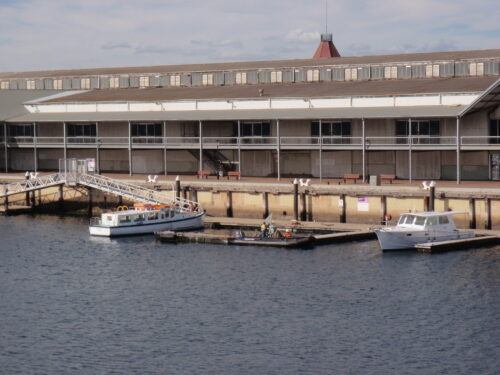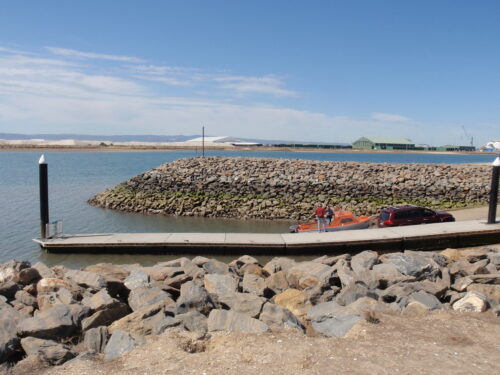Alex Chalupa, Senior Biosecurity Officer, Aquatic Pest Response, Biosecurity SA, Invasive Species Unit, Department of Primary Industries and Regions, has sent us this message below. It is the annual reminder to stakeholders regarding Pacific Oyster Mortality Syndrome (POMS).
Hi Everyone,
Hope you are coping well in these extraordinary times.
It’s beginning to warm up again and with that increases the risk of POMS becoming active in the Port River.
Please find a letter from Biosecurity SA’s Executive Director, outlining steps stakeholders can take to minimise the risk of spreading the virus to other regions of SA.

Dear Stakeholder
ONGOING RISKS ASSOCIATED WITH PACIFIC OYSTER MORTALITY
SYNDROME IN THE PORT ADELAIDE OYSTER POPULATION
SYNDROME IN THE PORT ADELAIDE OYSTER POPULATION
Vessel operators are urged to continue taking steps to prevent the spread of Pacific
Oyster Mortality Syndrome (POMS) present in the Port River.
These key steps include ensuring vessels (hull and niche areas) are clean of
biofouling, appropriate management of ballast water, and ensuring oysters aren’t
deposited into South Australian waters. More detail on these are provided below.
POMS virus was first detected in feral Pacific Oyster populations in the Port River in
Adelaide on 28 February 2018. The Department of Primary Industries and Regions
(PIRSA) continues to detect Pacific Oyster Mortality Syndrome (POMS) in the Port
Adelaide River. This means the risk of inadvertently spreading the disease remains.
The POMS virus can spread quickly in pacific oyster populations causing extremely
high mortality and would devastate farmed oysters if introduced to farming areas of
the State. The South Australian oyster growing industry is worth up to $40 million per
year.
What can you do to limit the spread of the POMS virus?
1. Clean hulls and niche areas
Good vessel cleaning practices minimises biofouling and reduces the risk of shellfish
carrying the POMS virus being attached to your vessel. This includes:
• cleaning your vessel (hull and niche areas) before leaving for new
destinations. By cleaning your vessel at a slipway you reduce the risk of the
POMS virus being transported through the buildup of vessel biofouling
• regularly inspect your vessel and clean areas prone to biofouling. Check the
hull and niche areas such as internal sea water systems, anodes, docking
strips, sea chests, pipe openings, propellers, shafts and rudders
• remember to dry and or maintain your marine equipment. If possible allow 48
hours for your cleaned equipment to fully dry before moving to another area
of the state. Remove all entangled seaweed and other organisms from ropes,
anchors, buoys and other equipment
• regularly apply suitable antifouling coating to your hull, including to niche
areas, ensuring it is re-applied well before the end of the lifespan of the coating
• develop a biofouling management plan and record book in place for each
vessel. Advice can be found at:
www.marinepests.gov.au/commercial/vessels#manage-biofouling
In addition to helping to protect the South Australian aquaculture industry in South
Australia, these practices will affect your vessel’s performance and reduce running
costs.
2. Ballast water maintenance
There are Commonwealth legislated requirements in relation to ballast water. The
national ballast water requirements are available at:
www.agriculture.gov.au/biosecurity/avm/vessels/ballast.
In addition, to avoid spread of POMS to other areas within the gulfs, operators
should:
• avoid uptake of ballast water within the Port River whenever possible; and
• avoid discharging/exchanging ballast water in oyster growing regions in
South Australia.
3. Do not deposit any pacific oysters in State waters
You should never place or discard live or dead oysters (including shells) or other
seafood into SA waters.
For further information please see the following webpages:
www.pir.sa.gov.au/biosecurity/aquatics/biofouling_and_ballast_water and
www.pir.sa.gov.au/aquaculture/aquatic_animal_health/pacific_oyster_mortality_syn
drome
If you have any questions in relation to issues associated with aquatic diseases,
please contact Dr Matt Bansemer, A/Manager Aquatic Animal Health (PIRSA
Fisheries & Aquaculture) on 8429 0505 or Matthew.Bansemer@sa.gov.au.
If you have questions in relation to vessel biofouling or ballast water management,
please contact Ms Catherine Cooney, A/Senior Biosecurity Advisor, Aquatic Pests
(PIRSA Biosecurity) on 0428 103 869 or catherine.cooney@sa.gov.au.
Yours sincerely
Nathan Rhodes
EXECUTIVE DIRECTOR
BIOSECURITY SA
20 November 2020
If you have any questions in relation to the letter, contact details are included in the letter.
Kind Regards
Alex Chalupa
Service l Professionalism l Trust l Respect l Collaboration & Engagement l Honesty & Integrity l Courage & Tenacity l Sustainability



In the longer term, please ask yourselves the question: why worry about the spread of POMS in SA when it reduces the viability of feral oyster aquaculture?
About time we got cracking with incentives to develop a native oyster industry.
Even our local Flat or Mud oyster Ostrea angasi tastes better ,but we’re always focused on exotic foods and blinkered wrt the huge damage that does to the endemic biodiversity.